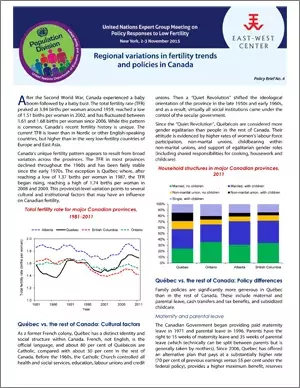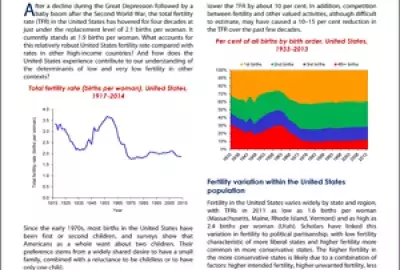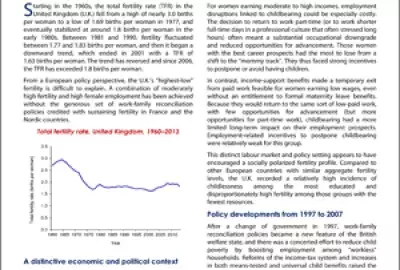Error message

After the Second World War, Canada experienced a baby boom followed by a baby bust. The total fertility rate (TFR) peaked at 3.94 births per woman around 1959, reached a low of 1.51 births per woman in 2002, and has fluctuated between 1.61 and 1.68 births per woman since 2006. While this pattern is common, Canada's recent fertility history is unique. The current TFR is lower than in Nordic or other English-speaking countries, but higher than in the very low-fertility countries of Europe and East Asia. Canada's unique fertility pattern appears to result from broad variation across the provinces. The TFR in most provinces declined throughout the 1960s and has been fairly stable since the early 1970s. The exception is Québec where, after reaching a low of 1.37 births per woman in 1987, the TFR began rising, reaching a high of 1.74 births per woman in 2008 and 2009. This provincial-level variation points to several cultural and institutional factors that may have an influence on Canadian fertility.
|
After the Second World War, Canada experienced a baby boom followed by a baby bust. The total fertility rate (TFR) peaked at 3.94 births per woman around 1959, reached a low of 1.51 births per woman in 2002, and has fluctuated between 1.61 and 1.68 births per woman since 2006. While this pattern is common, Canada's recent fertility history is unique. The current TFR is lower than in Nordic or other English-speaking countries, but higher than in the very low-fertility countries of Europe and East Asia. Canada's unique fertility pattern appears to result from broad variation across the provinces. The TFR in most provinces declined throughout the 1960s and has been fairly stable since the early 1970s. The exception is Québec where, after reaching a low of 1.37 births per woman in 1987, the TFR began rising, reaching a high of 1.74 births per woman in 2008 and 2009. This provincial-level variation points to several cultural and institutional factors that may have an influence on Canadian fertility.
|
Policy Briefs - United Nations Expert Group Meeting on Policy Responses to Low Fertility







